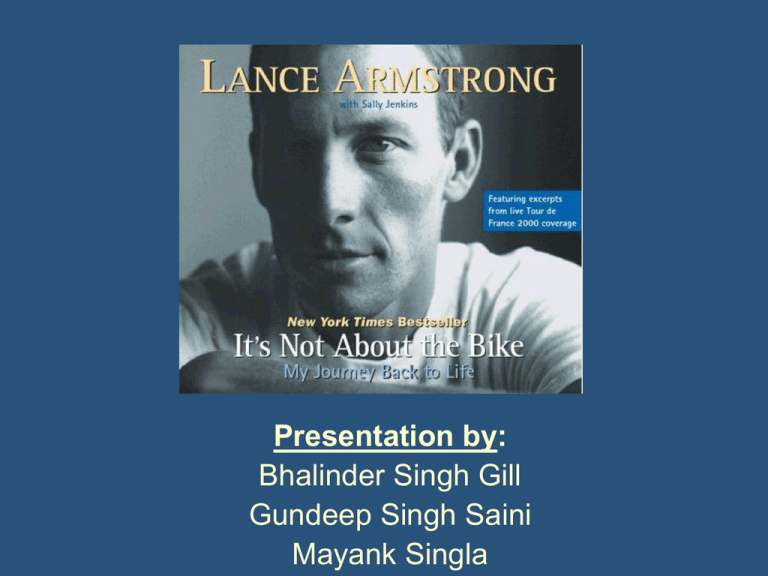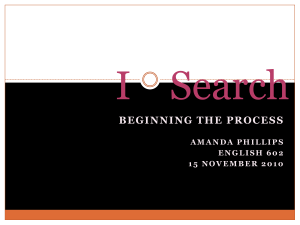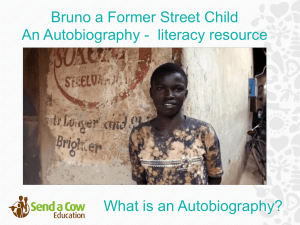Document
advertisement

Presentation by: Bhalinder Singh Gill Gundeep Singh Saini Mayank Singla “I want to die at a hundred years old after screaming down an Alpine descent on a bicycle at 75 miles per hour. A slow death is not for me. I don’t do anything slow, not even breathe. I do everything at a fast cadence: eat fast, sleep fast” Contents About Lance Armstrong Autobiography The Early Years The Cancer Phase Post Cancer Period Tour De France The Metamorphosis Style of Autobiography Reasons for writing the autbiography Critical Analysis About Lance Armstrong Retired American professional road racing cyclist Won the Tour De France, professional cycling's most prestigious race, a record seven consecutive times from 1999 to 2005, the most by any professional cyclist This was accomplished several years after having undergone extensive chemotherapy in 1996, to treat testicular cancer that had metastasized to his brain and lungs Dogged throughout his career by doping allegations His athletic success and his dramatic recovery from cancer inspired Armstrong to commemorate his accomplishments in conjunction with Nike through the Lance Armstrong Foundation, a charity founded in 1997 AUTOBIOGRAPHY The Early Years The Early Years Never had a father. His biological father split up with his mother before he was two Though of meagre means, his mother never left him wanting “why does any kid love a bike? Its liberation and independence, your first set of wheels. A bike is freedom to roam, without rules and without adults” The Early Years Was never fond of his step dad He used his adolescent resentments as a fuel for his competitive energy. “when it came to anything involving a ball, I was no good” He thus channeled his energy to triathlon sports – swimming, running and cycling He was good at enduring pain and embarrasement “If it was a sufferfest, I was good at it” The Early Years Armstrong began his sporting career as a triathlete, competing and winning in adult competitions from the age of 15 At 16, he became a professional triathlete, thus giving him an early break in the career He was soon earning about $20,000 an year and even bought a car with his own money “I felt shunned at time. I was the guy who did weird sports and who didn’t wear the right labels” The Early Years Was deeply influenced by his mother in his childhood, especially since she was a single parent “my mother had given me more than any teacher or father figure ever had. When it came to never quitting, to not caring how it looked, to gritting your teeth and pushing to the finish, I could only hope to have the stamina and fortitude of my mother, a single mother with a young son and a small salary – and there was no reward for her at the end of the day” “every time she said make an obstacle an opportunity, make a negative a positive, she was talking about me, about her decision to have me and the way she had raised me” The Early Years He got noticed by the US National cycling team due to his consistent performance and got a call from the team director, Chris Carmichael Chris Carmichael went on to become his coach throughout all his years at Tour De France competitions The Early Years He was defiant by nature and did not always follow the instructions of Carmichael, acting more on his own will, leading to inconsistent performance “I wasn’t trying to be a jerk. I was just being Texan. The Toro de Texas the Spanish press named me” The Early Years He was insecure and defensive, not totally confident of how strong he was. He never worked as a team and only rode for himself “In a long stage race, you give a little to make a friend, because you might need one later. Give an inch, make a friend. But I wouldn’t do it” He was very short tempered and foul mouthed. This didn’t go down well with other riders He was impatient and associated being patient with being weak AUTOBIOGRAPHY The Cancer Phase The Cancer Phase “Of course I should have known that something was wrong with me. But athletes, especially cyclists are in the business of denial. You deny all the aches and pains because you have to in order to finish the race. It’s a sport of self-abuse.” The Cancer Phase Upon getting some tests done at the local medical centre, he is diagnosed with testicular cancer that had metastasized to his lungs He undergoes surgery and subsequent chemotherapy to get treatment for the cancer even after his diagnosis, he continued to cycle. “cycling is so hard, the suffering is so intense, that it is absolutely cleansing. You can go out there with the weight of the world on your shoulders, and after a six hour ride at a high pain threshold, you feel at peace.” The Cancer Phase During the treatment, it is found that the cancer had progressed to his brain. He then consults two other cancer centres – one at Houston and the other at Indianapolis Upon consultation with both the centres, he decides to proceed with his treatment at Indianapolis At Indianapolis, he undergoes brain surgery and his chemo treatment is changed to VIP as it would not be as debilitating to his lungs The Cancer Phase During this phase he was felt particularly weak, nauseated and listless. His defiant nature still persisted – he would rather walk than use a wheelchair. “the irony was, the worse I felt, the better I got. That was chemo for you” The Cancer Phase When he had started his treatment, he was given a survival chance of 50% by the doctors. However, it was later revealed that his chances were quite slim (around 3%) and those figures were given just to make him feel better. After 2 months of extensive treatment, his chemotherapy was stopped. During the following year he was constantly monitored to check for the relapse of the cancer AUTOBIOGRAPHY Post Cancer Period Post Cancer Period One month after the completion of his treatment, he launched the Lance Armstrong Foundation to raise funds for cancer awareness and research. In spring 1997, in spite of being unsure about his health, he wanted to get back on the bike. He suffered sudden swings of mood during this time regarding his getting back to biking. Post Cancer Period He met with Kristin with whom he went to Europe and realised that biking was just his profession and wanted to spend his time with family and friends. Chris Carmichael urged him to start racing again. He agrees to Chris after pondering over. But his former team Confidis refused to accept him again as they had lost faith in him as a cyclist. Finally, US Postal Service team agrees to take him in. Post Cancer Period His first race with his new team did not go very well and he had to quit midway through it because of severe climatic conditions. He gets his final inspiration in Boone, North Carolina where he goes to train for his retirement race and comes back with a new will and determination to race again. Tour de France In upcoming year, he participated in several races but the most significant win of his career came in 1999 in the form of Tour de France. He won this competition successively for the next six years after which he retired. The Metamorphosis Emotional: After cancer treatment, he became more humane and patient. “ I was no longer the angry and unsettled young rider I had been. My racing was still intense , but it had become subtler in style and technique.” Physical: He lost weight and his body became more apt for biking ” I was leaner in body and balanced in spirit.” Style of Autobiography Throughout the autobiography, he uses simple language It appears as if he is having a heart-to-heart talk with the reader. Reasons for writing the autobiography To provide inspiration to other cancer patients from his survival story To provide awareness of cancer and its treatment To demonstrate how patience and good sportsmanship can go a long way in making a successful athlete Critical Analysis In the autobiography, he minces no words while describing his encounter with people / organisations whom he was not particularly fond of It is observed that he is very attached to his mother and constantly acknowledges the impact she has had on his life Comments by reputed Dailies “Having nearly lost his life, Lance Armstrong serves up his story for the rest of the world to wonder at, shudder at and learn from” - Guardian “An inspiring Story” - Daily Telegraph “Unflinchingly documents a remarkable journey” - The Times “Pure inspiration” - Scotsman Thank You







